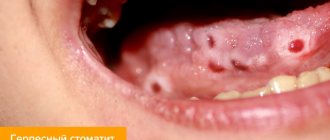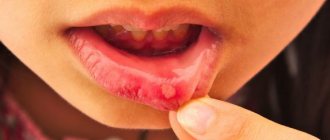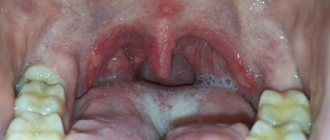- Gallery
- Reviews
- Articles
- Licenses
- Vacancies
- Insurance partners
- Partners
- Controlling organizations
- Schedule for receiving citizens for personal requests
- Online consultation with a doctor
- Documentation
Pancreatitis is inflammation of the pancreas. There are 2 main forms of this inflammation: acute and chronic. These forms are more common in adults.
In recent years, it has become common to identify another one - reactive pancreatitis (correctly called reactive pancreatopathy) - which is more common in children.
When the pancreas becomes inflamed, the enzymes secreted by the gland are not released into the duodenum, but begin to destroy it (self-digestion). The enzymes and toxins that are released often enter the bloodstream and can seriously damage other organs: the brain, lungs, heart, kidneys and liver.
In 97% of cases, the main cause of pancreatitis is:
- poor nutrition;
- monotonous food;
- regular overeating;
- acute poisoning;
- preference for fried, fatty, spicy foods and fast food instead of healthy foods.
Pancreatitis has the same symptoms regardless of the form of the disease: chronic or acute. The main symptom of the disease is acute pain in the abdominal area.
Causes of stomatitis in children
What causes stomatitis in children? The causes of this disease in a child are different. These include dirty hands, fragile children’s immunity, and the peculiarities of thermoregulation, on which the respiratory system directly depends. You need to understand that a child’s mucous membrane, unlike an adult’s, is a very thin and vulnerable substance, so any infection occurs very quickly. At an early age, the child’s salivation is not yet fully formed, but salivary enzymes play a very important role in protecting the body. As a result, the mucous membrane often dries out, cracks appear, infection occurs, followed by stomatitis. It is impossible not to take into account long-term use of medications, for example, antibiotics, as well as neuropsychiatric disorders, unfavorable living conditions, poor child care and poor oral hygiene of the parents themselves.
Often it is the parents who help the doctor find out the cause of the disease. Only they can try to analyze what caused the blister, ulcer or plaque to appear. For example, the child ate something wrong, they bought a new toothpaste or toothbrush, or maybe the baby suffered a temperature change.
What could be the reason
Bad breath in children is the result of processes that occur in the oral cavity or inside the body. The main cause of the unpleasant odor is pathogenic bacteria that actively multiply and create a special microflora.
Possible causes of bad breath in children.
- Poor nutrition. Products such as garlic, onions, etc. are not considered in this case, since the appearance of a strong aroma after eating them is normal. A pathological odor is considered to be one that arises from bacterial microflora that forms plaque on the teeth after eating. For example, sour foods or sweets.
- Poor oral hygiene. The most common reason is that children not only do not like to brush their teeth, but also often do not do this procedure thoroughly enough. The smell may appear due to a large accumulation of plaque.
- Dental diseases. “Odor” from the mouth of children can be a symptom of caries, gingivitis, periodontitis, stomatitis and other pathologies of the teeth or gums.
- Accumulation of plaque on the tongue. If a child brushes his teeth thoroughly, the tongue often remains unattended. At the same time, it is on the tongue that a large number of bacteria can accumulate, which, under favorable conditions, will actively multiply and emit an unpleasant odor.
- Respiratory tract infections. By analogy with the defeat of the oral mucosa by pathogenic microbes, bacteria can multiply in the nasopharynx, maxillary sinuses, tonsils, etc. In this case, the risk of a purulent process cannot be excluded.
- Gastrointestinal diseases. Often an unpleasant odor from a child’s mouth is the result of a malfunction of the pancreas. In rare cases, this symptom indicates problems with the stomach or intestines.
Before you begin to take action, it is necessary to establish the reasons why your child’s breath smells.
What are the types of stomatitis in a child?
It is more common for everyone to say “stomatitis”, but it would be more correct to say “stomatitis”, since this is a general concept for a whole group of diseases. Depending on the causes, stomatitis can be divided into several types, each of which has a number of characteristics.
Viral, herpes, or herpetic stomatitis in children
One of the most common types of childhood stomatitis is caused by the herpes simplex virus. Usually a child becomes infected with it through airborne droplets. The virus is also transmitted through dishes, toys, and household items. Most often, herpetic stomatitis appears in a child between the ages of one and four years. The disease begins as a cold, accompanied by lethargy and fever. Sometimes a runny nose and cough occur. Around the second day, small round or oval erosions of a light yellow color with a bright red border appear on the lips, tongue, and inside of the cheeks. Swelling appears, the gums begin to bleed, and the child refuses to eat.
Traumatic stomatitis in a child
The disease is caused by mechanical trauma to the oral cavity. For example, burns from hot food, a too-hard pacifier, the habit of chewing a pencil. Also, traumatic stomatitis often occurs in children with malocclusion due to frequent biting of the cheeks and tongue.
Candidal stomatitis
Appears in children under one year of age. The cause is fungi of the Candida species. The main symptom is the appearance of white plaque in the baby’s mouth. It is worth noting that it should not be confused with the usual plaque after feeding. A cause for alarm is if the plaque does not go away and the child refuses to eat.
Drug-induced or allergic stomatitis in children
Caused by certain allergies or reactions to medications. If this type of disease is suspected, the allergen should be identified and removed, otherwise there is a risk of unpleasant consequences, including anaphylactic shock.
Each type of stomatitis is characterized by a certain childhood age. In young children, candidal or fungal infections (thrush) are often observed. At the age of “I want to know everything” in a child of 3-4 years, stomatitis, as a rule, is infectious in nature, when the infection gets through dirty hands or objects. From one year to four years, we often observe an acute herpetic type of disease.
Chronic recurrent aphthous stomatitis
This is a chronic inflammatory disease of the oral mucosa of a non-infectious nature, characterized by periodic exacerbations and remissions.
Causes of the disease:
- allergic reactions in a child;
- diseases of the gastrointestinal tract;
- respiratory infections;
- functional disorders of the central and autonomic nervous system;
- chronic inflammatory diseases of the nasopharynx (otitis, sinusitis, etc.)
School-age children and adolescents are more often affected.
Main signs of the disease:
on the mucous membrane of the oral cavity (usually lips, cheeks, transitional folds of the upper and lower jaws, the lateral surface and back of the tongue) one or several areas of redness with rounded painful aphthae covered with a yellowish coating appear; the child’s general condition may deteriorate, the child refuses to eat; healing occurs with adequate treatment after 5-7 days without a scar.
In order to prevent exacerbations of the disease, it is necessary:
- regular visits to the dentist (at least 2 times a year);
- elimination of foci of chronic infection in the oral cavity (treatment of carious teeth and periodontal diseases);
- systematic hygienic oral care.
If there are signs of disease, you should consult a pediatric dentist!
Symptoms of stomatitis in children
For all types of stomatitis, the common and defining signs are inflammation of the oral mucosa and the appearance on any of its parts, such as the tongue, the inside of the lips, cheeks, pharynx, of various formations in the form of erosions, blisters, characteristic plaque, and in cases of traumatic stomatitis - traces of burns and biting. It is important to understand that stomatitis is not just one acute or chronic disease with certain classic symptoms. Each type of stomatitis has its own specific cause, and it may not manifest itself in the same way. Therefore, they need to be treated differently.
How to treat stomatitis in children
As we have already found out, there is no single algorithm for treating stomatitis in children. Each case is individual in its own way. Very often it happens like this: a mother comes in the hope that the doctor will prescribe an ointment, and she will immediately cure the child with it. This doesn't happen! It is necessary to understand what preceded the inflammation, taking into account the child’s age, stage and severity of the disease. Treatment is carried out both locally and symptomatically, i.e. symptoms are relieved. Doctors—a pediatric dentist and a pediatrician—give their recommendations, and it is possible to involve highly specialized specialists such as an ENT specialist, a mycologist, or a dermatologist. Of course, there are some textbook principles that experts follow to relieve or ease pain and prevent complications. We are talking about observing the rules of oral hygiene, diet and sleep, treating the mucous membrane with special gels, solutions and applications. For example, for allergic stomatitis in children, antihistamines are recommended, for herpetic forms - antiviral drugs, and if there is a fever - antipyretics. It is important to immediately contact a specialist when you discover a problem.
Preventing bad breath in children
To prevent the occurrence of this unpleasant problem, you should follow a few simple but very important rules.
- From the moment the first baby tooth emerges, parents need to brush their baby’s teeth twice a day with a soft brush. And when the child grows up, make sure that he correctly performs the procedure on his own.
- Teach your child to brush his teeth, show him by personal example how to do it. If you have difficulty in this matter, contact your hygienist for advice. This specialist has many manuals, films and interesting devices to teach your child the necessary skills in a playful way.
- Review your diet, add more sour fruits - apples, oranges and lemons increase salivation.
- Eliminate sweets from your diet and replace them with honey.
- Make sure your child drinks enough fluids. But not juice and soda, but clean drinking water.
- Visit your dentist regularly for preventative checkups.
Dear parents, remember that strong breath in children is a possible symptom of much more serious problems. It is in your power to prevent the formation of pathological processes in the body or stop their development at an early stage. Pay close attention to any negative changes in your child's health to prevent complications and chronic diseases in the future.
Caring for a child with stomatitis
The participation of parents in treatment and proper care of the child is not just important - they are decisive. With stomatitis, it is necessary to strictly follow the treatment plan, which is often very labor-intensive, so the result depends on parental care and control. The oral cavity is a kind of epicenter of pain, so it is not surprising that the child will be capricious a lot. Therefore, it is important for parents to be patient and persistent.
Nutritional Features
Most mothers and fathers are concerned about the question of how to feed a child with stomatitis. Firstly, it is necessary to eat only soft, warm and mushy foods, for example, in the form of purees. The main thing is that the food is high in calories and not heavy, because the child’s immunity is already weakened. After eating, be sure to rinse your mouth so as not to provoke the development of stomatitis and not to add any additional infection. If a child is ill, the diet should include the exclusion of spicy, sour, sweet foods and citrus fruits.
Pain relief and care
For stomatitis in children, pain relief is necessary. It is carried out with the help of various medications in order to avoid food refusal and poor sleep. In addition, for stomatitis in children, proper treatment of the oral cavity is very important. A doctor should recommend what to treat and rinse a child’s mouth with.
How to treat stomatitis in children at home?
On the Internet you can find descriptions of many ways to treat stomatitis in children at home. However, experts consider many of these virtual tips not only useless, but also dangerous. There is always a risk of allergies, so you should not use infusions and decoctions, even if you are absolutely sure that it will not harm the child. Instead of wasting time, it is necessary to undergo diagnostics and consultation with a dentist and pediatrician, who will prescribe the correct treatment regimen.










